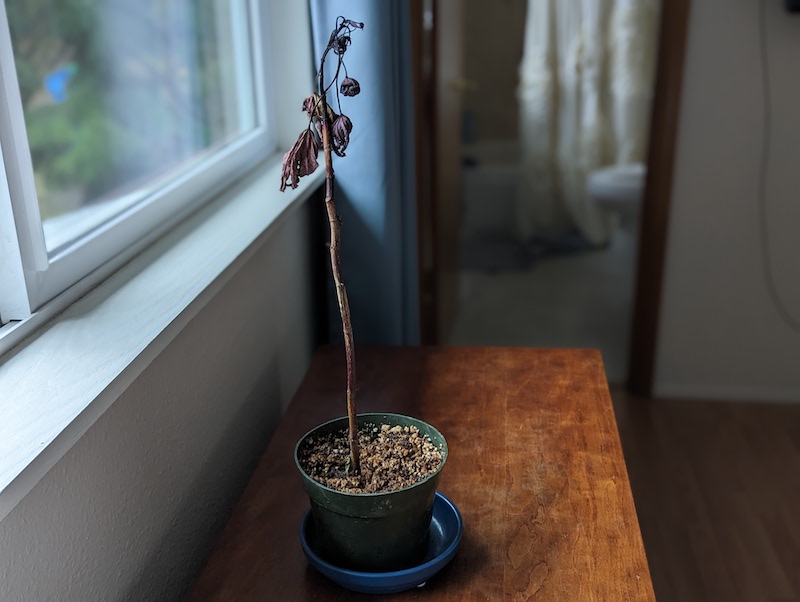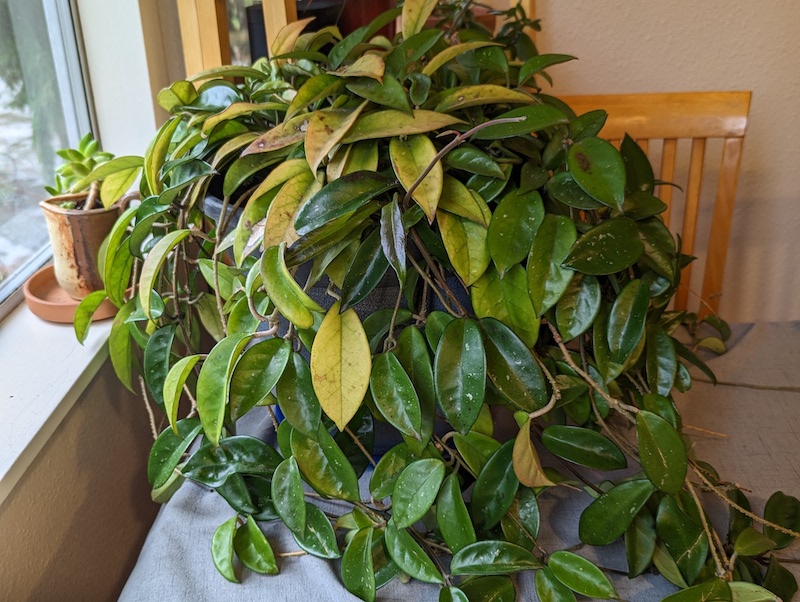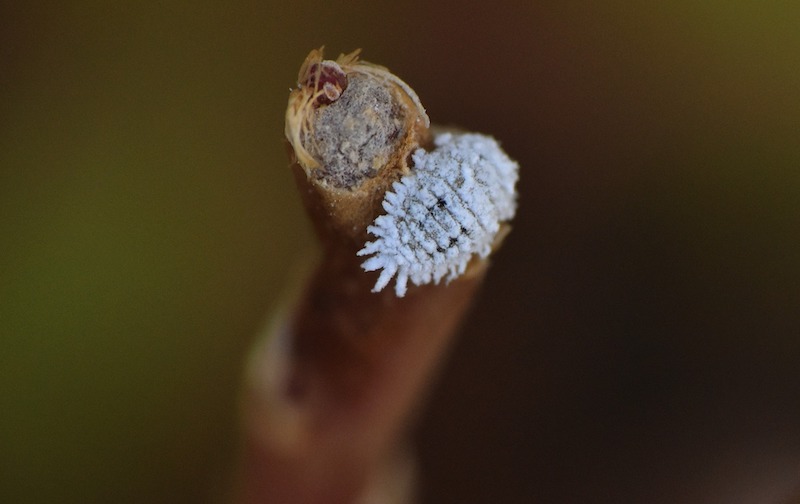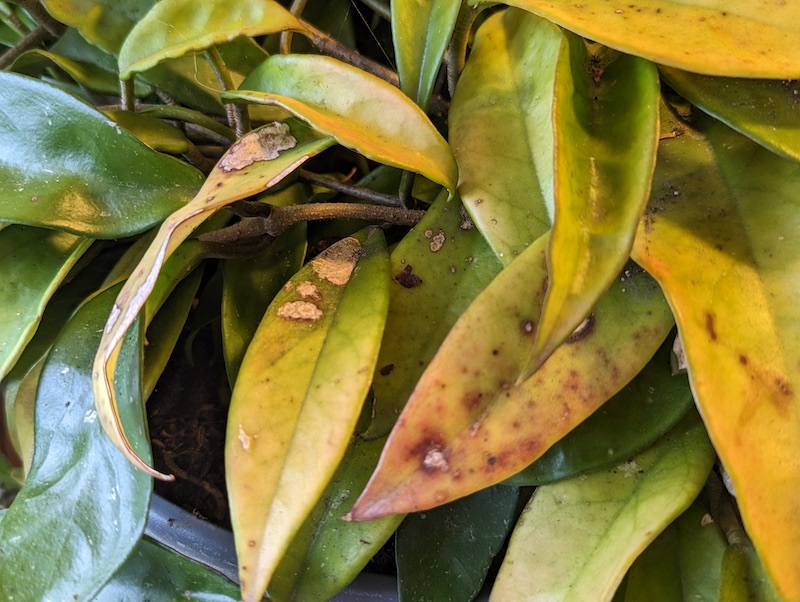Houseplant Is Dying
It is common to encounter health issues with indoor plants, as dim, air-conditioned homes are an unnatural growing environment for them. While some houseplants can adapt to indoor conditions, others may struggle due to improper lighting, humidity, and watering. This is why it is important to research the optimal growing conditions for a plant before bringing it into your home.
One of the most common reasons houseplants fail to thrive is inadequate lighting. Lighting that is too low can lead to another very common houseplant issue–overwatering. On the flip side, lighting that is too bright, rooms that are too warm, and air that lacks humidity can all lead to underwatering. It is a good idea to check your plant’s soil frequently and at different times of the year to really hone in on the right watering schedule or method.

While it can be disheartening to see your beloved houseplants start to yellow, drop leaves, or show other signs of stress, it is possible to reverse damage if it is caught early enough. To prevent houseplant problems from becoming overwhelming, we recommend always checking soil for moisture before watering, scouting your plants for pests, and observing what kind of light your home provides prior to choosing a plant for your space. Many houseplant problems and symptoms can look similar, and using all of your senses – sight, smell, and touch – can aid in the diagnosis process.
Houseplant Leaves Turning Yellow
Yellowing leaves is perhaps the most common symptom that you may encounter when growing houseplants. This common problem can have many causes, such as overwatering, underwatering, low humidity, pests, too much light, not enough light, nutrient deficiencies, etc. For this reason, you really need to grab your magnifying glass and don your investigator hat! While yellowing leaves will not turn green again, it is possible that with a bit of investigation, you can prevent further damage.
First, let’s look at lighting. Houseplants are typically categorized by the kind of light they need: bright light, bright indirect light, medium light, and low light. Plant parents often make the mistake of placing their houseplants either too far away from a window or in front of a window that is not as bright as they may think. This low light can cause a plant’s leaves to yellow as they are not receiving enough light to produce the food they need to survive. Conversely, houseplants that haven’t adapted to direct sunlight can become sunburned, leading to burns on the leaves that may look like bleached spots. Lighting issues are easy to solve by moving the plant to a more appropriate spot or providing artificial grow lights.
The next most common reason a houseplant’s leaves are turning yellow is improper watering, often exacerbated by inadequate light. When plants are sitting in soil that is too wet for too long, their roots can become mushy. This overwatering will often appear as yellowing or browning leaves all over the plant. Left damp for too long, houseplant roots can even become infected with diseases and die off, often referred to as root rot, ultimately causing the plant’s demise.
When plants are underwatered, the oldest, lowest leaves will become yellow and eventually drop as the plant directs its energy and water to its newer leaves. Both over- and underwatering problems can be ameliorated by checking your plant’s soil frequently. Before ever watering, use your finger or a soil probe to check for moisture deep in the pot. We always recommend planting houseplants in pots with drainage holes as well, or keeping plants in their grow pots so that they can easily be lifted from cachepots when watering.
Once watering, pests, and disease are all ruled out as causes of yellowing leaves, you may find that your houseplant is in need of fertilizer. While houseplants tend to use nutrients at a lower rate than their outdoor counterparts, a low-strength feeding may rejuvenate an older houseplant or heavy feeder. Houseplants do best when given houseplant-specific fertilizer, though a diluted general-purpose fertilizer may do just fine. It is a good idea to do a bit of research prior to fertilizing houseplants to avoid over-fertilizing and damaging your plants.

Houseplant Pests
When bringing plants into your home, it is likely that at some point, pests will follow. Spider mites, scale, mealybugs, fungus gnats, aphids, and whiteflies are all common houseplant pests. To prevent a pest problem from getting out of control, scout your houseplants frequently, checking all sides of the leaves, the soil, and flowers for signs of infestation.
Spider Mites are perhaps the most common houseplant pest because they are difficult to detect. These eight-legged arachnids can be quite small. Like their name suggests, spider mites form webbing on the leaves of a plant, which is the easiest way to find them but often allows them to be confused with a harmless spider. Spider mites use needle-like mouthparts to suck the juices from plants, leaving faint white spots on a plant's leaves and stems. To treat spider mites, spray your plants top to bottom with neem oil, insecticidal soap, or other organic miticide, taking care to cover the entire plant and follow up as directed.
Mealybugs are possibly the easiest pest to identify. These large, white, fluffy bugs are often confused with mold or lint. Though they easily hide in the crevices between leaves, they are easily treatable with household items; Q-tips dipped in rubbing alcohol and applied directly onto the area is usually enough to do them in. Because they easily hide in cracks and crevices, you will want to check back every few days for more and may even have to try a systemic pesticide if the infestation is bad enough.

Fungus gnats are some of the most hated houseplant pests, though they tend to do the least damage to plants. These small, black, flying bugs can be identified by their poor flying skills, often finding themselves in your glass of water. Fungus gnats love moist soil and can often be an indication that some of your plants are overwatered. To treat fungus gnats, we recommend setting out yellow sticky traps or covering the soil with a layer of sand or gravel to disrupt the breeding cycle. You can also spray your soil with neem oil or use Mosquito Bits, which are granules that gradually release a beneficial bacterium into your soil that vanquish fungus gnat larvae.
Houseplant Diseases
While diseases tend to be a less common issue than lighting, watering, and pest issues, it is possible to encounter the occasional houseplant disease. Some plants are more prone to disease than others. The pathogens need to be present in order to cause disease – they do not come out of thin air. This is one reason to quarantine plants for about a month when bringing them into your home and avoid diseased-looking plants in a store. In addition, plants are often able to fight off diseases on their own, only becoming the most prone to infection when their health is already compromised, be it from physical damage, improper watering, the wrong growing conditions, etc.

Root rot is a common issue among houseplants, typically resulting from overwatering. When plants are overwatered, their roots become soft and damaged, making them susceptible to bacterial and fungal diseases. Root rot can be reversed if caught early enough, though it often occurs when plants are already weakened.
When spots on a plant’s leaves are determined to not be caused by any other common issues (watering, lighting, etc.), the culprit may be an infection. Molds and mildews often appear as raised spots and can be rubbed off of a leaf. Bacterial spots tend to appear wet, have a smell, or are accompanied by yellow halos. Fungal infections can look like yellowing or brown leaf tips and spots. Viruses can be confused with natural foliage variegation, with yellow striations or spots. Identifying specific pathogens can be difficult, especially when they appear as common yellow or brown leaf spots. If you suspect that your plant has a disease, reach out to your local land-grant university’s extension office to have a professional identify the disease so that you can treat it appropriately.
Houseplants Not Blooming
Some houseplants are chosen for their ability to bloom indoors. The most common cause for a lack of blooms indoors is inadequate lighting. Without enough bright indirect light, plants do not have the energy to produce flowers. This is often the case with peace lilies, aphelandra (zebra plant), and bromeliads. Once plants are moved into a brighter spot, they are often able to bloom again. Some plants, such as phalaenopsis orchids, need a change of temperature in order to bloom. Other blooming plants may fail to do so when they are not provided consistent watering, humidity, and more. Doing a bit of research on your particular plant can definitely help solve any blooming issues.
 |
Author Lynn Gusman - Published 1-18-2023 |
